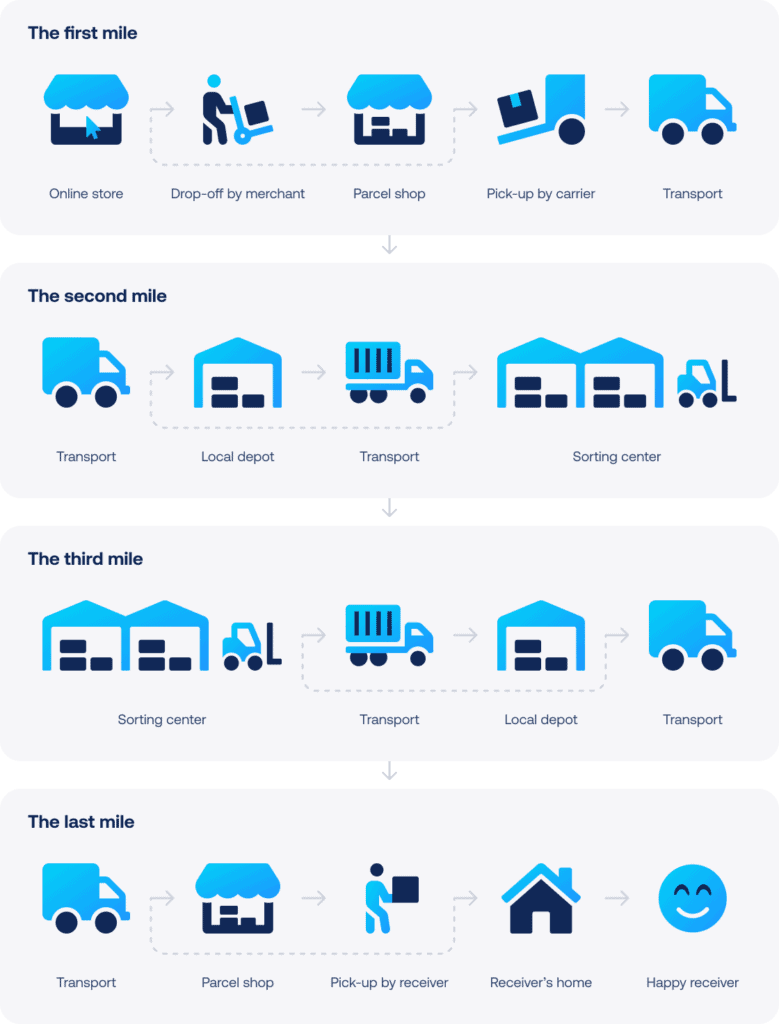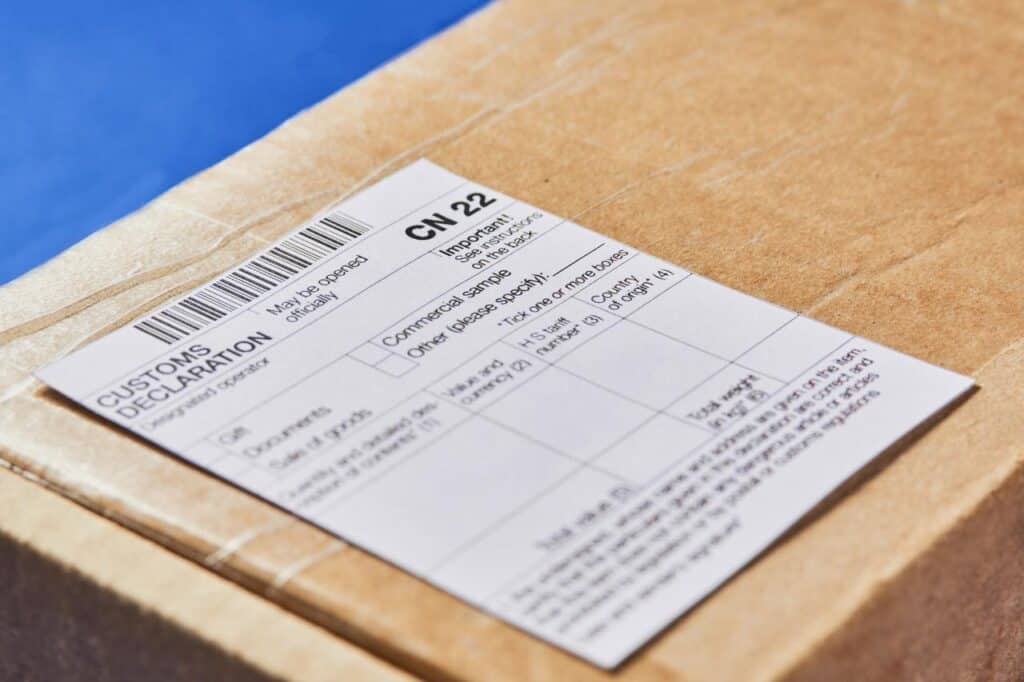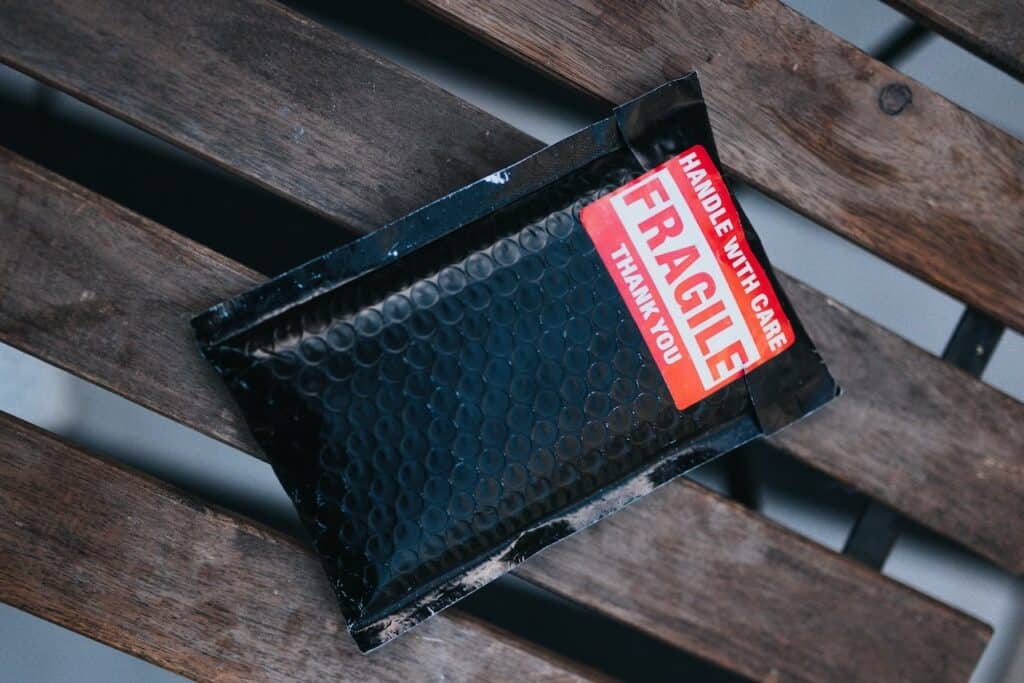Do you find yourself losing sleep over lost and damaged parcels or surprised by unexpected surcharges? Well, you’re not alone in facing shipping problems. As an e-commerce retailer, your success depends on more than just selling products. Smooth shipping is essential to keeping your customers happy and your business growing.
These shipping challenges may be all too familiar and happen more often than anyone would like to admit. However, they present an opportunity for you to showcase resilience and ensure a smooth shipping experience going forward. Time to tackle the unavoidable, prepare for what’s to come, and start conquering the shipping process. Read on to explore the most common e-commerce shipping problems and how you can overcome them.
What does the shipping journey look like?
The shipping journey starts as soon as the package gets picked up or dropped off at the parcel shop. From there, the package is transported to a local depot, and then a sorting center. Depending on the driver’s route, it’s also possible that the packages are directly transported to the sorting center. After the sorting process, the package might go to another local depot again before finally ending up at your customer’s home or chosen pick-up location.
What does this all mean for you? There are plenty of opportunities for things to go wrong.
Product shipping process flow

Higher demand and external disruptions play their part in heightening challenges, such as the increased likelihood of lost parcels during peak season. While you can’t control what comes your way, you can make sure you’re not caught off guard when deliveries don’t go as planned. Being aware of the most common shipping problems can help you handle them quickly or avoid them altogether.
Does this resonate with you? Let’s take a look at the most common shipping pitfalls and learn how to tackle them head-on.
Pitfall #1: Unexpected shipping costs are prevalent
Have you ever been caught by surprise by an unexpected surcharge thanks to a label issue or an oversized package? Factors like size, location, weight, speed of delivery, and packaging can heavily influence the final cost of shipping. Shipping surcharges, such as peak surcharges, can come as a surprise when you start out with shipping. But even the more seasoned shippers are caught off guard by this. Understanding the true cost of shipping for your products can help you maintain your profit margin and avoid passing extra costs to your customers. Good for you, and them!
Make sure you know how and when shipping surcharges apply. Once the package reaches the sorting facility, it’s checked for things like size constraints, special handling, label legibility, shape, and whether the actual or volumetric weight will be used to determine the shipping cost. The package needs to be transported too, and carriers can apply surcharges depending on the time of year and destination.
Using data from 700,000 deliveries with surcharges, Sendcloud found these to be the most common:
- Fuel surcharges
- Seasonal surcharges
- Surcharges for private delivery
- Non-bendable packages
- Illegible addresses
- Incorrect weight classes
Luckily, the shipping experts have spoken — to avoid costly shipping surcharges, it’s crucial to have a good understanding of your products, shipping routes, and specific carrier requirements. Is it evident who is responsible for the costs? Whether it’s private deliveries or product returns, be crystal clear on who you want to foot the bill to avoid confusion or unexpected expenses. Are you asking customers to pay extra for expedited delivery? Do you cover the cost of re-shipping with paid returns? Once you’ve thought it through and determined the best process for your business, custom automation helps ensure the best shipping method and carrier are assigned to each order depending on factors like weight and value.
Pitfall #2: Full carrier networks during peak periods
During peak shipping periods, carrier networks face increased volumes. This surge in activity often leads to the delivery infrastructure operating at maximum capacity, which can result in longer delivery times and temporary service disruptions. If you want packages to be delivered on time, encouraging your buyers to order their products by a certain date is crucial during these peak periods. However, despite your best efforts, complications may persist when you only have a limited carrier service selection.
Multi-carrier parcel management is the way to go if you want multiple carriers to choose from, instead of relying on just one. This means having a plan B to avoid delays when your preferred carrier is disrupted. Working with multiple carriers also ensures suitable and efficient delivery options for your customers to get the job done as quickly as possible. It’s like having a fleet of carriers at your fingertips but without the expense and hassle of activating multiple carriers.
Pitfall #3: Shipment pick-up hassles and no-shows
Creating labels is not always the end of your shipping responsibilities. Next up: getting the packages out of the door. If you prefer not having to go to a post office to drop off packages, request a package pick-up if you want to have the carrier come to your location.
The customer’s order is prepped and good to go, but it’s stuck in the waiting game, yet to hit the road. Does this scenario sound familiar? Sometimes carriers don’t show up or take extra long, leaving you to deal with the delay. When this happens, it not only disrupts logistical operations but also negatively impacts the customer experience if not dealt with as soon as possible.
Streamlining your pick-up process is essential to reinforce the reliability of your shipping service. For your next shipment, get it right from the start:
- Check if your shipping volume meets the requirements for a parcel pickup.
- Be sure to schedule collections in advance to allow for processing time.
- Have a backup or alternative carrier in case the primary carrier faces issues.

Pitfall #4: International packages get stuck at customs
If you ship internationally, it’s essential to provide accurate and complete documentation of your shipment to avoid any customs-related hold-ups. But it may feel like you need a Ph.D. in international shipping to make it work. If you’re stuck manually filling out paperwork like commercial invoices and worrying about compliance, you need a solution that allows you to expand your market and get comfortable with international shipping.
Here’s what you need to tackle international shipping:
Beginner — If you’re new to international shipping, try a handy customs declaration form tool. You’ll also need an HS Code Finder to fill this in properly.
Pro — Leveling up means using comprehensive shipping software that allows you to generate a compliant customs form automatically, ready for printing and placement in your package. Your paperwork gets done in a snap and human errors are non-existent.
Pitfall #5: Package delivery delays happen frequently
Delivery problems occur due to a long list of reasons — weather conditions, traffic, or other unforeseen circumstances. This leaves you the one stuck dealing with questions about the whereabouts of the package. In your frustration, you might think it’s as easy as knowing at which hub the package is located, going there, and finding it.
What is often overlooked is that the types of facilities that hold your package operate on a massive scale with intricate processes. This makes it nearly impossible to manually pinpoint individual packages. Locating a specific brown box within the extensive landscape of packages is like finding a needle in a haystack.
Here’s what you do have control over:
Internally — Stay organized, know your orders’ status, and always have a contingency plan to handle unexpected issues. Put the control back in your hands and mitigate the effect of delivery delays on your business.
Externally — Remember, your customers want to know what’s going on as much as you do. Proactive communication and expectation management can help satisfy even the most frustrated customers.
Pitfall #6: Packages often get returned to sender
Packages are most often returned due to incorrect addresses or customers being unavailable for the delivery. As frustrating as this may be, it’s crucial to take proactive measures to minimize the chances of this happening.
First and foremost, customers need to know when to expect a package. Otherwise, there’s a high chance they miss it. If you want to change an address, it’s good to be aware that some carriers allow address modifications in early processing stages, while others restrict changes once in transit for security reasons. Flexibility may vary based on service level and carrier policies, and certain carriers may charge an extra fee.
Using manual processes to deal with your customer’s delivery are bound to cause issues, even when double-checking. Switch to a streamlined system and automate your processes for efficiency and accuracy:
- Do what you can to ensure online shoppers fill in the correct address at checkout.
- Check and note down the unique address format per country and per carrier.
- Use automated order processing to manage orders faster and with fewer errors.
- Send automatic tracking notifications to keep customers informed of delivery details.

Pitfall #7: Not enough compensation for shipping incidents
Did you know that in cases where a package fails to reach its intended destination, the responsibility — and thus the cost for replacement — lies with you? The online store is legally obliged to reimburse the purchase price or send a new order.
The reality of shipping is that sometimes your packages get damaged, lost, or stolen. The big question is, do you need extra shipping insurance, or is the traditional carrier insurance enough when insurance is included?
Carrier insurance of this nature only covers up to a certain amount and does not include the replacement of the product. Regardless of the scenario, unfortunate shipping incidents require immediate solutions, yet claims done directly with a carrier take an average of 20 days to complete an investigation.
Insurance with better coverage offers peace of mind. It also comes highly recommended, especially during peak periods or when shipping expensive items. This small investment provides a reliable means of reimbursement and resolving incidents quickly. You benefit from a speedy 1-day claims process that covers the full sales price, as well as return shipping and reshipping.
Pitfall #8: Not every carrier fits with your business
Do you keep running into the same problems with shipping? As an e-commerce retailer, you know that your business relies on your partnership with carriers. Without them, your business would suffer. So, choose the one that is the best fit for your business.
Carriers have their differences — on the one hand, their strong points and on the other, their weaknesses. In the same way, every carrier has their specialty, meaning whether you’re shipping locally or to locations like the Isle of Man, there are specific shipping methods and carriers equipped for the special requirements.
This underlines the point that you need to choose carriers according to your business needs. It’s all about knowing who you can count on to handle things. When you have various carriers to choose from, providing the best service to your customers not only becomes manageable but it also opens up new possibilities for your business.

Navigate unavoidable global shipping problems and solutions with ease
Shipping doesn’t have to be chaotic and stressful. By taking proactive measures to handle potential and current shipping issues, you can ensure a smooth, affordable, and efficient shipping process for you and your customers. The key to achieving excellent shipping is to prepare as much as possible, take responsibility when things go wrong, and learn from mistakes to adapt for the next delivery.
Having a streamlined shipping solution is even better than having the best shipping strategy but dealing with everything manually. Ready to ditch the issues and try a shipping solution that allows you to automate and manage everything in one place? Time to stop ignoring the issues at hand and make stressing over your shipping problems a thing of the past.
















